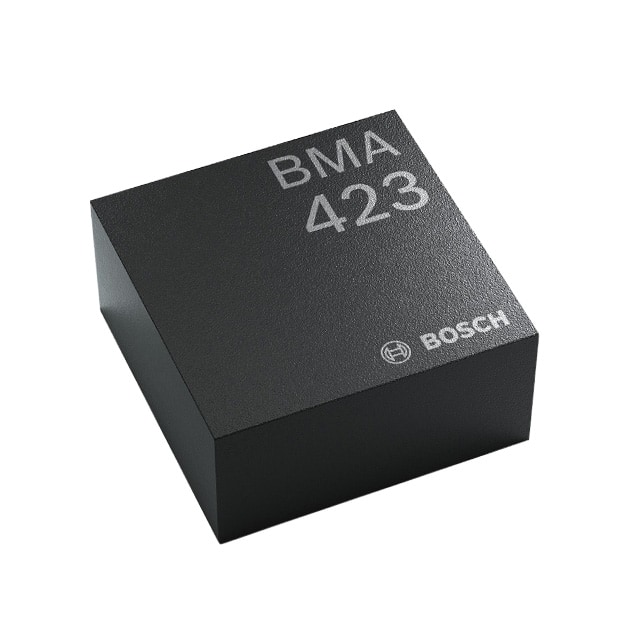Подробную информацию о продукте см. в характеристиках.

BMA423: Product Overview and Specifications
Introduction
BMA423 is a sensor product belonging to the category of motion sensors. It is designed for various applications that require accurate motion detection and measurement. This entry provides an overview of BMA423, including its basic information, specifications, detailed pin configuration, functional features, advantages and disadvantages, working principles, detailed application field plans, and alternative models.
Basic Information Overview
- Category: Motion Sensor
- Use: Accurate motion detection and measurement
- Characteristics: High precision, low power consumption, compact design
- Package: LGA (Land Grid Array)
- Essence: Advanced motion sensing technology
- Packaging/Quantity: Available in tape and reel packaging, quantity varies based on customer requirements
Specifications
- Dimensions: 3mm x 3mm x 0.95mm
- Operating Voltage: 1.71V to 3.6V
- Output Data Rate: Up to 800Hz
- Interface: I2C and SPI
- Sensitivity Range: ±2g to ±16g
- Temperature Range: -40°C to +85°C
- Power Consumption: Low power consumption for extended battery life
Detailed Pin Configuration
The BMA423 sensor has a precise pin configuration that includes power supply pins, communication interface pins, interrupt pins, and ground pins. The detailed pin configuration can be found in the official datasheet provided by the manufacturer.
Functional Features
- Motion Detection: Accurately detects motion in multiple axes
- Step Counting: Integrated step counting algorithm for fitness and activity tracking applications
- Tilt Detection: Detects orientation changes and tilt angles
- Low Power Mode: Efficient low power modes for battery-operated devices
- Interrupt Functionality: Provides interrupt signals for motion events
Advantages and Disadvantages
Advantages
- High precision motion sensing
- Low power consumption for extended battery life
- Compact and space-saving design
- Integrated step counting algorithm for fitness applications
Disadvantages
- Limited sensitivity range compared to some alternative models
- Requires careful calibration for specific applications
Working Principles
BMA423 utilizes advanced MEMS (Micro-Electro-Mechanical Systems) technology to detect and measure motion. The sensor's internal components, including accelerometers and signal processing units, work together to accurately capture motion data and provide reliable outputs.
Detailed Application Field Plans
BMA423 is suitable for a wide range of applications, including: - Wearable fitness trackers - Smartphones and tablets for gesture control - Virtual reality and augmented reality systems - Industrial equipment for motion monitoring - IoT (Internet of Things) devices for activity tracking
Detailed and Complete Alternative Models
Several alternative models to BMA423 include: - BMA422: Similar features with a different sensitivity range - BMA455: Higher sensitivity range with comparable dimensions - BMA280: Lower power consumption with slightly reduced functionality
In conclusion, BMA423 offers high precision motion sensing capabilities with low power consumption, making it suitable for various applications in consumer electronics, industrial equipment, and IoT devices.
Word count: 470
Перечислите 10 распространенных вопросов и ответов, связанных с применением BMA423 в технических решениях.
What is BMA423?
- BMA423 is a 3-axis accelerometer sensor developed by Bosch Sensortec, designed for applications in consumer electronics, wearables, and IoT devices.
What are the key features of BMA423?
- BMA423 features low power consumption, high accuracy, and advanced gesture recognition capabilities, making it suitable for various motion-sensing applications.
How can BMA423 be used in wearable devices?
- BMA423 can be integrated into wearable devices to track motion, detect gestures, and enable features such as step counting and activity monitoring.
What technical specifications should I consider when using BMA423 in my design?
- When using BMA423, consider its operating voltage, communication interface (such as I2C or SPI), measurement range, resolution, and power consumption to ensure compatibility with your application.
Can BMA423 be used for screen rotation and gesture control in smartphones?
- Yes, BMA423's advanced gesture recognition capabilities make it suitable for implementing screen rotation and gesture control features in smartphones and other handheld devices.
How does BMA423 contribute to power efficiency in battery-powered devices?
- BMA423's low power consumption and configurable power modes help optimize energy usage in battery-powered devices, extending their operational life.
What are the common challenges when integrating BMA423 into a technical solution?
- Challenges may include sensor calibration, noise filtering, and optimizing gesture recognition algorithms to ensure accurate and reliable performance.
Are there any application examples where BMA423 has been successfully utilized?
- BMA423 has been used in applications such as fitness trackers, smartwatches, virtual reality controllers, and IoT devices requiring motion sensing and gesture recognition.
How can I access technical support or documentation for BMA423 integration?
- Bosch Sensortec provides comprehensive technical documentation, application notes, and support resources to assist with the integration of BMA423 into technical solutions.
What are the potential future developments or enhancements for BMA423?
- Future developments for BMA423 may focus on further improving power efficiency, expanding gesture recognition capabilities, and enhancing compatibility with emerging IoT standards.

